If you are someone that is content to sit inside and never leave the comfort
of your easy chair and chip bowl; you will most likely never need any of these
products.
For those that actually manage to get out and enjoy an active lifestyle
(even if it’s only once a year while on vacation) – yet still want to enjoy
using their electronic equipment in the most extreme situations…there is Aquapac.
Auquapacs are 100% waterproof cases specially made to hold everything from
PDAs to portable audio equipment, even most Camcorders!
Don’t let the brand name fool you though: What these rubberized cases
actually do is hermetically seal your electronic equipment into an environment that is also 100% free of dust, dirt,
snow, sand, oil & whatever else you could accidentally get on your high
dollar equipment.
Even though I am mainly focusing on the fact that you can store electronics
in these bags, I need to also mention that Aquapac also makes smaller bags to
carry personal belongings such as cash and passports. There are even larger
Document and Map Holders, which could come in very handy for people that need
access to such papers in extreme weather.
The three models I have been presented with for review will hold a PDA,
Digital Camera, and a Cellular phone. Since I live in West Texas, I can provide
most of the extreme conditions that these cases are made to protect against –
almost everything except for the snow! :0P
These Aquapacs will not protect your electronics from a drop onto a hard
surface, nor will they keep your electronics from being crushed. There is simply a
trade-off that has to be made: Do you want to be able to safely drop your
electronics, or do you want to be able to use them in some of the most
electronic-unfriendly environments – without having to worry about their safety?
The good news is that all of the Aquapacs include some sort of strap – whether
it be wrist, neck, or waist – so even on your most
klutziest day, you will be less likely to drop your expensive item.
Certain things about the three models I will review here today are basically
the same. They are all made of a tough, yet soft, plastic polymer material. They
will all float, and they will all keep your electronics safe from the elements.
They have an extreme temperature range of 100ºF (40ºC) to -15ºF
(-25ºC). Special Edition cases
are also offered that are made of a material that is still totally flexible at
-40ºF (-40ºC). Something to consider if you are planning on using your Aquapac
in truly extreme temperatures is that even if the Aquapac is able to take the
heat or cold – your sensitive electronic equipment inside the Aquapac may be
experiencing "melt-down" or "freeze-up", as the case may be.
Also, around 100°F (40°C), the Aquapac’s plastic will begin to soften, meaning
that if you are sitting in a hot tub trying to use your camera or PDA, the case
may actually begin to leak…
All of the Aquapacs use a clever clip system to lock out harmful elements,
called the Aquaclip. What
this system basically entails are two pieces of plastic that are perfectly
fitted together, and two swiveling levers that go from an open to closed
position. When the levers are opened all the way, you can disengage the two
plastic sides of whatever Aquapac you are using, and insert or remove your
equipment. When the levers are closed all the way, the "cam-lock system
provides sufficient pressure to create an efficient, airtight seal."
Aquapac claims that their Aquaclips are fully functional after being opened and closed
*10,000 times!
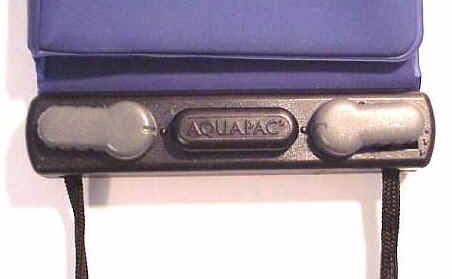
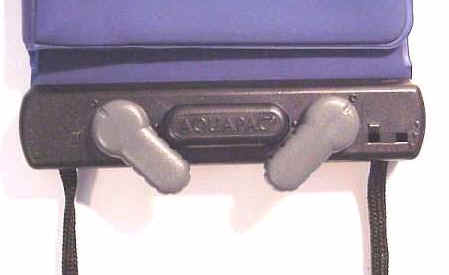
The Aquaclips are made of plastic, so they don’t rust. They also come in
various lengths, from 3.35" (85mm) to 11.81" (300mm). This means that
some of your much larger equipment can possibly fit inside an Aquapac.
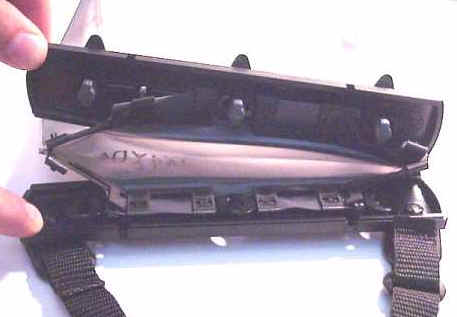
The shorter the Aquaclip, the better rated it is for constant
immersion. The majority of the Aquaclip lengths maintain a 100% waterproof seal
after constant immersion to 30ft (10m) for half and hour. The largest sizes,
from 7.9" – 13.5" (20-35cm) are rated for 3ft (1m) submersion
for 30 minutes.
*Tested by Bath University’s School of Engineering
Properly Using and Taking Care of any Aquapac:
There are a couple things you should do before you jump into using your Aquapac
for the first time. Company literature recommends that you perform the Bubble
Test. It is recommended that you seal something worthless inside the
Aquapac, and submerge everything under water in a sink. You may see a couple air
bubbles escape – which is okay, as air bubbles may simply be escaping from the
clip. What you are looking for here is a constant stream of air bubbles,
indicating that your Aquapac has a problem. Aquapac
will arrange for a replacement, if this is the case.
When you insert equipment in an Aquapac, you want to be sure that nothing
obstructs the two parts of the Aquapac from coming together and making a perfect
seal. Things that can obstruct this include but are not limited to: sand, straps
on the actual item, parts of the electronics item, itself.
You’ll want to examine the Aquapac every time you are about to use it, and
make sure that you didn’t unknowingly poke a hole in it at some point between
now and the last time.
If your Aquapac comes into contact with chlorinated water, salt water, or sun
creams, you should always rinse it afterwards with fresh water.
Okay – with all of that information out of the way, lets take a look at the
cases I received…
The 100% Waterproof PDA Wallet:
This Aquapac is blue, and looks similar to a book style-case, in that it has a
flap that snaps closed over the screen of your PDA. That is where all other
similarities end.
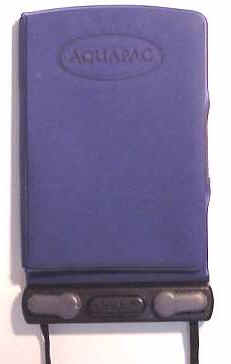
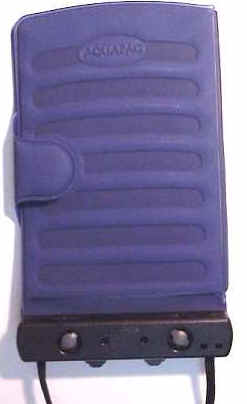
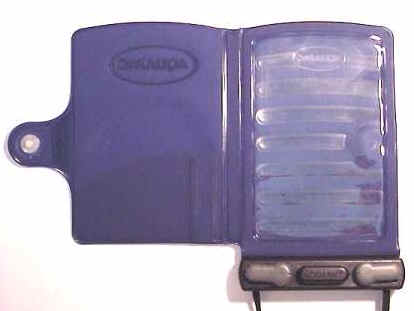
This actual, usable area of this case measures 4.25" (107.89mm) wide x
6.5" (165mm) tall. Since it lays flat when empty, you have to take that
into consideration when deciding if it will fit your PDA. I tested all of the
following PDAs, which fit perfectly: Palm m505, m100, IIIc, Handspring Visor
Deluxe, Casio EM-500, HP Jornada 548, and Compaq iPAQ. In the iPAQ’s case: it
will fit when naked, with GM’s Silver Slider,
and the basic sleeve. It will be too tight for a CF sleeve, much less the
PCMCIA sleeve.
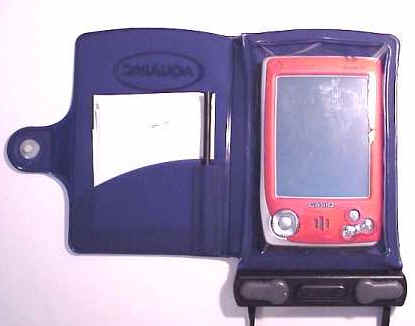
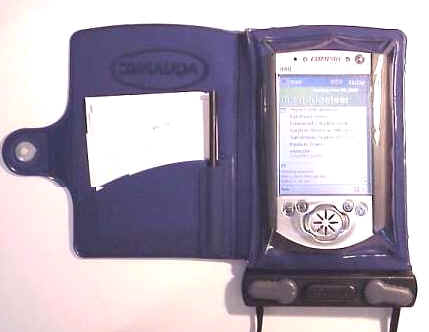
Once inserted in the Aquapac, your PDA can hang from around your neck, and in
a worst-case scenario will float upon hitting the water.
There is a large see-through, write-through window for the front of your PDA.
I found that although it was a bit different in feel, it was not at all
difficult to actually write on any PDA’s screen with this method.
The only questionable thing that I found about this case, was the fact
that there are slots for a stylus and a piece of paper on the inside flap that
are oriented for when you are looking at the case in a book style. Knowing that
a neck-strap is integral to this Aquapac’s design, I think they should have made
the slots orientate from what would be the bottom of the case when it was
hanging upside-down from around a wearer’s neck. This upside down picture better
illustrates what I am talking about – as this is how the case would be
orientated when worn.
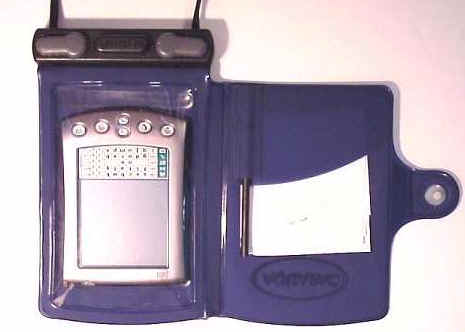
As they are placed now, you would most likely lose any inserted stylus or
papers the minute you put the Aquapac on. If this were changed – I would find
absolutely no CONS to this case.
Can I rant for just a minute? Have you checked the price for a ruggedized PDA
lately? Finding a PDA that has been sealed for dust and is any amount of water-resistant
can set you back over a thousand dollars! Then you have to deal with the
fact that you don’t get to pick and chose what form factors are available for
you to purchase! I think that an item like this is a great idea on so many
levels. First – you can use your PDA in harsh conditions, and not fear about it
being compromised; Second – When you are not in those harsh conditions, you can
put your PDA in another case, and it will still look civilized; and Third – the
cost of doing it this way is minimal – you simply buy whatever PDA you
prefer, and pay for this Aquapac. Awesome!
Price: £29.99, or approx. $49.95 MSRP
Pros:
100% Waterproof, dustproof, etc.
Floats if dropped in Water
Can use stylus through the window
Cons:
Stylus & paper slots are orientated in such a way that they would not hold
contents securely when wearing this Aquapac
The 100% Waterproof Digital Camera Case:
I cannot tell you how much I wish that I had had this particular case when I
went to Hawaii! My huge (by some of today’s digital camera standards) Sony
Mavica FD81 fits perfectly in this Aquapac. With the built-in neck-strap it
shouldn’t be too much of a hassle to carry your camera either on the beach or in
the water.
This is one of the larger cases, so while it is not rated as highly for long
term immersions, I could have easily taken it snorkeling with me. I really feel
like I missed out now, knowing that I could have taken digital pictures while we
were enjoying that activity.
The actual, usable space of this Aquapac measures: 8" (20cm) wide x
7" (17.75 cm) tall, and the base is 3" (7.5cm) wide. I am not
including the area taken up by the clip.
This case comes in gray, here is a full frontal:
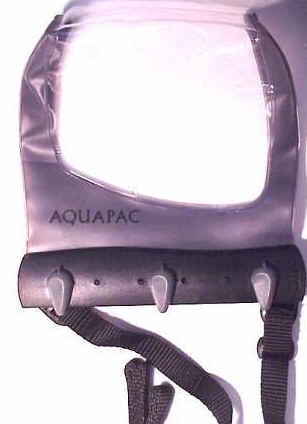
In the event that you are wondering how pictures taken through a layer of
plastic might come out, I have taken a picture of my camera in the Aquapac,
taking a picture of itself in the Aquapac. This picture was taken in my living
room with no flash.
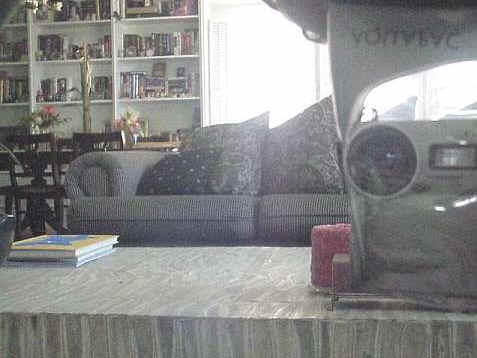
Here is another picture taken by my camera while inside the Aquapac:

The Aquapac uses a lens window made of clear PVC material so that pictures
taken through the plastic are unimpaired. Can you imagine feeling secure enough
about your expensive digital camera’s safety, to take it with you while
white-water rafting, or even while riding a jet-ski, or a snow-mobile, for that
matter? You can do all of that with this case.
There are a couple gotcha’s with this case: The flash will not always
work – it can reflect back off the plastic; so your best shots underwater will
be in clear water on bright days. There is not much room to use a manual zoom,
but digital zooms should perform just fine. Some cameras have lenses that will
jam if they meet any resistance (such as a PVC wall), you might want to check
with your manufacturer if you think this problem might affect you. None of the
Aquapacs will work with Single Lens Reflex (SLR) cameras.
I think that I will be using this bag at the ranch with my digital camera
from now on. We have dust and dirt blowing around like you would not believe. In
the past, I have hesitated to take my camera out, for fear of destroying the
lens. This gives me one less thing to worry about.
There is only one difficulty I had with this case – and it is such an
"oh-well" type thing, I hesitate to mention it. Obviously, when you
are trying to access the little buttons on the back of your digital camera, all
of the menu buttons for instance, it can be a bit more difficult through a layer
of plastic…there, I said it! :0P
Price: £29.99, or approx. $49.95 MSRP
Pros:
100% Waterproof, dustproof, etc.
Floats if dropped in Water
Pictures are taken in the bag, through a special optically clear polymer
Cons:
Can’t use camera’s flash while in Aquapac
Some cameras may have inherent lens problems with using inside a plastic bag
The 100% Waterproof Phone Case:
For all of you that want to use your cellular phone while you are on your
jet-ski, while sailing, snorkeling, or in the rain, in the middle of the desert,
or wherever…this is the answer.
This Aquapac is available in blue, orange, and gray. I received the blue one
for review. There are also four sizes available, fitting just about every size
cellular phone made. Mine is the small size, and it is easily big enough for
anything from an opened Motorola Vader, to a Nokia classic with the extended
battery pack installed.
The actual usable space of the small Aquapac measures 6.75" (17cm) tall
x 3.25" (8.2cm) wide. This case lays flat when empty, so realize that any
phone inserted is going to use up some of the available width. I am not taking
into account the area used by the clip, or by the area around the hole that the
neck lanyard passes through.
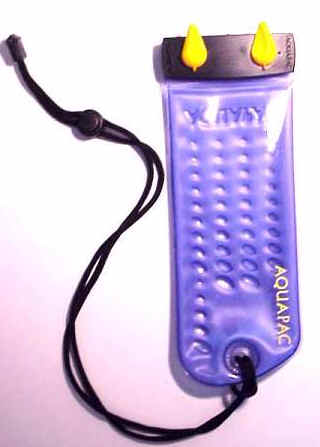
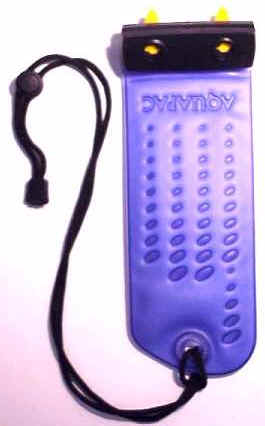
Even though I say that you can use it with a flip-phone, there are some
inherent problems with this. If your flip-phone has its dial pad on the outside
of the flip, you are going to be out of luck.
As you can see though, my husband’s Vader has the dial-pad on the
inside, which make the Aquapac perfect to use for those times when he is
concerned about getting it wet or dirty.
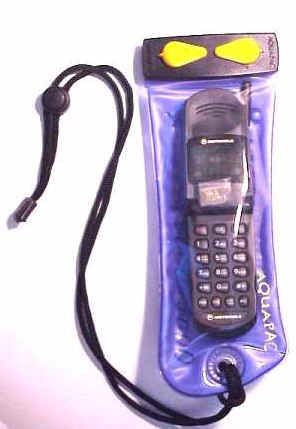
Another concern might be that you could lose a bit of volume when the phone
is inserted in the Aquapac. I did not find this to be the case, but if you need
to you can always crank your volume up a notch.
I think it is an excellent product, and one my husband has already snagged
for his own use!
Price: £14.99, or approx. $24.99 MSRP
Pros:
100% Waterproof, dustproof, etc.
Floats if dropped in Water
You can use the phone through the case
Perfect for classic-style phones, such as Nokia
Cons:
Encasing flip-phones with outside
dial-pads can be a
problem
Conclusion:
Each of these Aquapacs does exactly what it was made to do. I don’t know of any
finer cases, if you are in a hazardous-to-electronics environment, to protect and preserve your
electronics and other personal belongings from the surrounding elements.
All cases come with a one-year guarantee against manufacturing or material
defects, but with careful use, they should last much longer.
If your company that would like to have a custom Aquapac made for your
product, or branded with your logo – they can do it. Contact them at [email protected].
Frost King P115R/3 Clear Polyethylene Drop Cloths (3 Pack), 9' x 12' x 1Mil
Amazon Basics Clear Thermal Laminating Plastic Paper Laminator Sheets, 9 x 11.5-Inch, 200-Pack, 2.8mil
12% OffProduct Information
| Price: | |
| Manufacturer: | Aquapac |



Gadgeteer Comment Policy - Please read before commenting
Recorded by Nikon d5000 with Aquapac.
http://www.youtube.com/watch?v=fvCX-zUK1z8